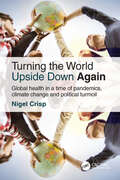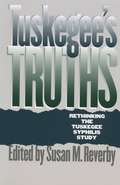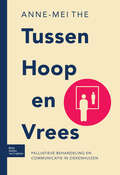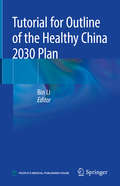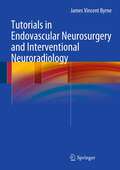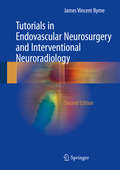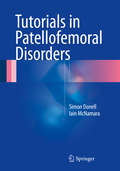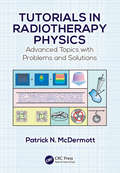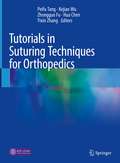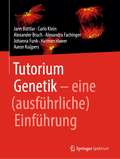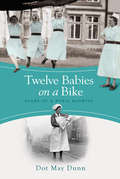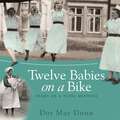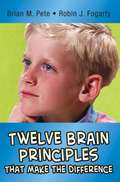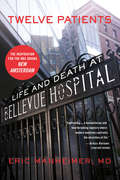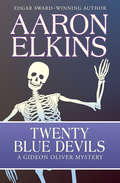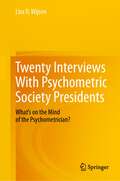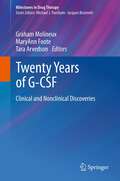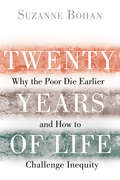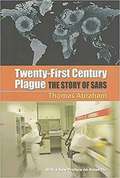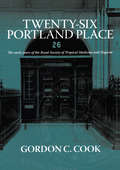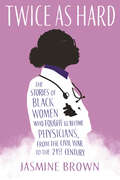- Table View
- List View
Turning the World Upside Down Again: Global health in a time of pandemics, climate change and political turmoil
by Nigel CrispIn Turning the World Upside Down Nigel Crisp argued that the most affluent and powerful countries in the world can learn a great deal about health from lower income countries with their different insights and experiences and their ability to innovate free from vested interests and received wisdom. In Turning the World Upside Down Again, he argues that they need to go further and listen to and learn from disempowered communities in their own countries. He describes how combining the learning from different countries and communities can lead us to a new ecologically based vision for health and new and practical ways of improving health for ourselves, our communities and our planet. This second edition, 12 years after the first, is extensively re-written and fully updated, drawing on examples from around the world and reflecting what has already been learned from the COVID-19 pandemic and from the onset of climate change. Turning the World Upside Down Again continues the search for understanding begun in the first edition and describes how western scientific medicine, which has served us so well in the 20th Century, must adapt and evolve further and faster to cope with the demands of the 21st Century.
Tuskegee's Truths: Rethinking the Tuskegee Syphilis Study
by Susan M. ReverbyBetween 1932 and 1972, approximately six hundred African American men in Alabama served as unwitting guinea pigs in what is now considered one of the worst examples of arrogance, racism, and duplicity in American medical research--the Tuskegee syphilis study. Told they were being treated for "bad blood," the nearly four hundred men with late-stage syphilis and two hundred disease-free men who served as controls were kept away from appropriate treatment and plied instead with placebos, nursing visits, and the promise of decent burials. Despite the publication of more than a dozen reports in respected medical and public health journals, the study continued for forty years, until extensive media coverage finally brought the experiment to wider public knowledge and forced its end.This edited volume gathers articles, contemporary newspaper accounts, selections from reports and letters, reconsiderations of the study by many of its principal actors, and works of fiction, drama, and poetry to tell the Tuskegee story as never before. Together, these pieces illuminate the ethical issues at play from a remarkable breadth of perspectives and offer an unparalleled look at how the study has been understood over time.
Tussen hoop en vrees: Palliatieve behandeling en communicatie in ziekenhuizen
by Anne-Mei TheTussen hoop en vrees is een aangrijpend verhaal over de laatste levensfase van kankerpatiënten. In Nederland sterven per jaar 40. 000 mensen aan kanker. In dit boek wordt beschreven wat zij meemaken. Anne-Mei The liep vijf jaar mee op een afdeling longoncologie in een academisch ziekenhuis en volgde patiënten vanaf het moment waarop ze te horen kregen ongeneeslijk ziek te zijn tot hun overlijden. Zij maakt ons deelgenoot van de gesprekken tussen arts en patiënt. Het besluit om te worden behandeld. De hoop op genezing. Hoe patiënten en dierbaren elkaar ontzien. Het contact tussen medepatiënten. En het voorbereiden op het nabije levenseinde. De rode draad door het boek is in hoeverre artsen patiënten de medische waarheid wel of niet moeten zeggen: een vraag die ons allen aangaat. Tussen hoop en vrees is de publieksuitgave van The's proefschrift.
Tutorial for Outline of the Healthy China 2030 Plan
by Bin Li“Healthy China 2030” is a national strategy for improving the health of the population and coordinating health and socio-economic development, and a major means for the country to participate in global health governance and meet targets set in the 2030 Agenda for Sustainable Development. This outline of the plan will be a blueprint and an action plan for facilitating the development of Healthy China.This tutorial book is a guide for “Outline of the Healthy China 2030 Plan” released on October 25, 2016. This book is organized by 29 chapters. It uses data, background description and figures to facilitate readers to know the plan.The book Editor-in-Chief Bin Li is the Former Minister of National Health Commission of PRC, and is the Vice Chairman of the National Committee of the Chinese People's Political Consultative Conference. The book Associate Editor-in-Chief Xiaowei Ma is the Minister of National Health Commission of PRC.
Tutorials in Diagnostic Radiology for Medical Students
by Michael Lee Ciaran E. RedmondThis book provides a practical guide to diagnostic radiology, with each chapter presenting a case-based tutorial that illustrates a specific aspect of diagnostic radiology required for undergraduate study. In addition, it discusses and assesses issues concerning basic principles in diagnostic radiology, imaging of head trauma, non-traumatic neurological emergencies, chest radiographs, pediatric radiology, and emerging radiological technologies. Tutorials in Diagnostic Radiology for Medical Students is intended as a self-study guide, and offers a valuable asset for medical students and trainee radiologists, as well as educators.
Tutorials in Endovascular Neurosurgery and Interventional Neuroradiology
by James Vincent ByrneThis book aims to provide the trainee and practicing minimally invasive neurological therapist with a comprehensive understanding of the background science and theory that forms the foundation of their work. The contents are based on the tutorial teaching techniques used at the University of Oxford and are authored by the MSc Course Director. The tutorial is a learning episode focussed on a particular topic and intended to guide the student/reader through the background literature, to highlight the research on which standard practices are based and to provide the insights of an experienced practitioner. Each chapter of the book covers a different topic to build a complete review of the subspecialty, with in-depth discussion of all currently used techniques. The literature is reviewed and presented in context to illustrate its importance to the practice of this rapidly expanding field of medical treatment.
Tutorials in Endovascular Neurosurgery and Interventional Neuroradiology
by James Vincent ByrneThis book aims to provide the trainee and practicing minimally invasive neurological therapist with a comprehensive understanding of the background science and theory that forms the foundation of their work. The contents are based on the tutorial teaching techniques used at the University of Oxford and are authored by the MSc Course Director. The tutorial is a learning episode focussed on a particular topic and intended to guide the student/reader through the background literature, to highlight the research on which standard practices are based and to provide the insights of an experienced practitioner. Each chapter of the book covers a different topic to build a complete review of the subspecialty, with in-depth discussion of all currently used techniques. The literature is reviewed and presented in context to illustrate its importance to the practice of this rapidly expanding field of medical treatment.
Tutorials in Patellofemoral Disorders
by Simon Donell Iain McnamaraThis book adopts a case-based approach to the management of patellofemoral disorders with the aim of helping orthopaedic surgeons at all levels of experience to decide whether individual patients referred with patellofemoral problems should be treated conservatively or operatively. A series of real-life case stories are used to illustrate every stage of the decision-making process and to explore the reader's higher-order thinking around patient management. In each case study, the patient's history, clinical and imaging findings, and management are reported, during the course of which the reader is asked searching questions. The reader is then able to compare his or her responses with those given by the authors, which are provided at the end of each case-specific chapter. This format ensures that knowledge and understanding improve as the reader progresses through the book. Although the cases are addressed primarily from the standpoint of the orthopaedic surgeon, the dominant management strategy is non-operative in many of them. Beyond surgeons, the book will also be of value for musculoskeletal physiotherapists with a particular interest in the knee.
Tutorials in Radiotherapy Physics: Advanced Topics with Problems and Solutions
by Patrick N. McDermottThe Topics Every Medical Physicist Should Know Tutorials in Radiotherapy Physics: Advanced Topics with Problems and Solutions covers selected advanced topics that are not thoroughly discussed in any of the standard medical physics texts. The book brings together material from a large variety of sources, avoiding the need for you to search through and digest the vast research literature. The topics are mathematically developed from first principles using consistent notation. Clear Derivations and In-Depth Explanations The book offers insight into the physics of electron acceleration in linear accelerators and presents an introduction to the study of proton therapy. It then describes the predominant method of clinical photon dose computation: convolution and superposition dose calculation algorithms. It also discusses the Boltzmann transport equation, a potentially fast and accurate method of dose calculation that is an alternative to the Monte Carlo method. This discussion considers Fermi–Eyges theory, which is widely used for electron dose calculations. The book concludes with a step-by-step mathematical development of tumor control and normal tissue complication probability models. Each chapter includes problems with solutions given in the back of the book. Prepares You to Explore Cutting-Edge Research This guide provides you with the foundation to read review articles on the topics. It can be used for self-study, in graduate medical physics and physics residency programs, or in vendor training for linacs and treatment planning systems.
Tutorials in Suturing Techniques for Orthopedics
by Peifu Tang Kejian Wu Zhongguo Fu Hua Chen Yixin ZhangThis book introduces the surgical suture techniques in orthopaedics. These techniques have been recognized as a crucial part for wound care and surgery-related prognosis. Training of fellows on suture techniques is of great importance. This book provides a standard tutorial on how to be proficient in surgical suture performance. The history and basic concepts are introduced. Important issues when considering suture methods, including site infections, suturing materials, room setups, cosmetics and drainage are also discussed fully. Different types of suture techniques applying to orthopaedic surgeries are presented with illustrations. The author strives to implement the principle that orthopaedic theory should be connected with clinical practice, highlight the application of theoretical knowledge, strengthen the pertinence and practicality of suture techniques, and reflect domestic and international development trends to the greatest extend.
Tutorium Genetik: eine (ausführliche) Einführung
by Jann Buttlar Carlo Klein Alexander Bruch Alexandra Fachinger Johanna Funk Harmen Hawer Aaron KuijpersGenetik geht jeden an, ob man für eine Prüfung lernt, oder einfach nur ein Lebewesen ist. Warum nicht ein wenig mehr darüber wissen?Dieses Buch gibt eine gute, leicht zu lesende und stellenweise sogar witzige Einführung in die Genetik und Molekularbiologie. Von den Grundlagen ausgehend erklärt es auch komplexere Zusammenhänge und konzentriert sich besonders auf die häufigsten Lern-Probleme von Studenten. Sowohl für Studierende der Biologie, medizinischer Fachgebiete oder interessierte Laien bietet dieses Buch daher einen hervorragenden Einstieg. Die Leser werden bei den chemischen Grundlagen abgeholt und über die Genexpression, die Genregulation und Mendels Erbsen bis hin zu den technischen Möglichkeiten der Genetik begleitet. Neben spannenden Exkursen bietet jedes Kapitel am Ende eine Kurzzusammenfassung, welche besonders für eine Wiederholung kurz vor der Prüfung geeignet ist.
Twelve Babies on a Bike: Diary of a Pupil Midwife
by Dot May DunnA young midwife's account of her training in the Midlands in the 1950s. A SUNDAY TIMES bestseller.It's 1957, and in a shattered post-war world, life goes on. Dot, a pupil midwife, negotiates the streets on her trusty old bicycle - come rain or shine - to help women in need.Living and working under the supervision of the strict Mrs O'Reilly, she must complete her training with twelve deliveries: there's Mrs Wardle who lives in a seedy slum; the eighth Clarke baby, born in an unusual place; the superstitious Wests, desperate for a boy; baby Murphy who is received with laughter; and brothel-worker Mrs Maloney.Amid lectures, textbooks and university dances, Dot must saddle up at any time of the day and night to attend deliveries. But just when she thinks she's got the measure of the job, fate deals her an unexpected hand...
Twelve Babies on a Bike: Diary of a Pupil Midwife
by Dot May DunnA young midwife's account of her training in the Midlands in the 1950s. A SUNDAY TIMES bestseller.It's 1957, and in a shattered post-war world, life goes on. Dot, a pupil midwife, negotiates the streets on her trusty old bicycle - come rain or shine - to help women in need.Living and working under the supervision of the strict Mrs O'Reilly, she must complete her training with twelve deliveries: there's Mrs Wardle who lives in a seedy slum; the eighth Clarke baby, born in an unusual place; the superstitious Wests, desperate for a boy; baby Murphy who is received with laughter; and brothel-worker Mrs Maloney.Amid lectures, textbooks and university dances, Dot must saddle up at any time of the day and night to attend deliveries. But just when she thinks she's got the measure of the job, fate deals her an unexpected hand...
Twelve Babies on a Bike: Diary of a Pupil Midwife
by Dot May DunnIt's 1957, and in a shattered post-war world, life goes on. Dot, a pupil midwife, negotiates the streets on her trusty old bicycle - come rain or shine - to help women in need.Living and working under the supervision of the strict Mrs O'Reilly, she must complete her training with twelve deliveries: there's Mrs Wardle who lives in a seedy slum; the eighth Clarke baby, born in an unusual place; the superstitious Wests, desperate for a boy; baby Murphy who is received with laughter; and brothel-worker Mrs Maloney.Amid lectures, textbooks and university dances, Dot must saddle up at any time of the day and night to attend deliveries. But just when she thinks she's got the measure of the job, fate deals her an unexpected hand...Read by Sara Poyzer(p) 2010 Orion Publishing Group
Twelve Brain Principles That Make the Difference (The\nutshell Ser.)
by Brian Pete Robin FogartyTwelve Brain Principles That Make the Difference by Brian Pete and Robin Fogarty, is about how the brain learns best and all the things teachers can do to facilitate the learning part of the teaching scene. This book presents a unique organization of Renate and Geoffrey Caine's twelve brain principles. The twelve principles are arranged in four specific quadrants. Each quadrant speaks to a particular aspect of the high-achieving classroom and highlights how instructional decisions are governed by the twelve principles.
Twelve Patients: Life and Death at Bellevue Hospital (The Inspiration for the NBC
by Eric ManheimerIn the spirit of Oliver Sacks Awakenings and the TV series House, Dr. Eric Manheimer's TWELVE PATIENTS is a memoir from the Medical Director of Bellevue Hospital that uses the plights of twelve very different patients-from dignitaries at the nearby UN, to supermax prisoners from Riker's Island, to illegal immigrants, and Wall Street tycoons-to illustrate larger societal issues. Manheimer is not only the medical director of the country's oldest public hospital, but he is also a patient. As the book unfolds, the narrator is diagnosed with cancer, and he is forced to wrestle with the end of his own life even as he struggles to save the lives of others.
Twentieth Interim Report of the Committee on Acute Exposure Guideline Levels: Part A
by National Research Council of the National AcademiesExtremely hazardous substances (EHSs), as defined in the Superfund Amendments and Reauthorization Act of 1986, can be released accidentally as a result of chemical spills, industrial explosions, fires, or accidents involving railroad cars or trucks used in transporting these substances, or intentionally through terrorist activities. It is also feasible that these substance can be released by improper storage and/or handling. Workers and residents in communities surrounding industrial facilities where EHSs are manufactured, used, or stored and in communities along the nation's railways and highways are potentially at risk of being exposed to airborne EHSs during accidental and intentional releases. This report provides technical guidance on establishing community Acute Exposure Guideline Levels (AEGLs) for certain hazardous chemicals. It reviews the scientific validity of AEGLs developed by the national Advisory Committee on Acute Exposure Guideline Levels for Hazardous Substances, identifies research priorities, and identifies guidance issues that may require modification or further development based on the toxicological database for the chemicals reviewed. This twelfth interim report offers recommendations for improving AEGLs for the following 15 chemicals: toluene, xylenes, ammonia, bromine, aniline, methyl ethyl ketone, hydrazine, iron pentacarbonyl, phosphine, chlorine, trifluoride, ethyleneimine, propyleneimine, allyl alcohol, ethylene oxide, and nickel carbonyl.
Twenty Blue Devils (The Gideon Oliver Mysteries #9)
by Aaron ElkinsThe &“shrewd, witty and self-deprecating forensic anthropologist&” travels to Tahiti to sniff out crime at a coffee plantation (Publishers Weekly). The dead man is the manager of Tahiti&’s Paradise Coffee Plantation, producer of the most expensive coffee bean in the world, the winey, luscious Blue Devil. Nothing tangible points to foul play behind his fall from a cliff, but FBI agent John Lau, a relative of the coffee‑growing family, has his suspicions. What he needs is evidence, and who better to provide it than his friend, anthropologist Gideon Oliver, the Skeleton Detective? Gideon is willing to help, but surprisingly—and suspiciously—both the police and the other family members refuse to okay an exhumation order. As a result, Gideon, to his surprise and against his better judgment, finds himself sneaking into a graveyard under cover of night with John, a flashlight, and a shovel—not exactly up to the professional standards of the world&’s most famous forensic anthropologist, but necessary under the circumstances. Gideon prefers his bones ancient, dry, and dusty, but the body he must examine had lain in the tropical sun for a week before it was found and then buried native‑style—shallow, with no casket—so it is not exactly his . . . well, cup of tea. But it is not the state of the remains that bothers him the most, it is the deeper human ugliness that his examination uncovers: subtle clues that do indeed point to foul play, to mistaken identity, and to a murderous conspiracy that may have percolated through the family for decades—and brewed a taste for murder. Twenty Blue Devils is the 9th book in the Gideon Oliver Mysteries, but you may enjoy reading the series in any order.
Twenty Interviews With Psychometric Society Presidents: What’s on the Mind of the Psychometrician?
by Lisa D. WijsenTwenty Interviews with Psychometric Society Presidents tells the stories of the people who are the driving forces of psychometric research, teaching and practice. In semi-structured interviews, twenty presidents of the Psychometric Society share how they moved into the psychometric field, what inspired them to pursue this path, and what still drives them to do their research. They also reflect on the current status, history, and future of their own field, considering psychometrics' most significant historical achievements, as well as the major challenges that lie ahead. This curated collection provides a wealth of historical knowledge that is relevant for every practicing psychometrician. Introspective and insightful, it exhibits the wide array of opinions and visions in the field. Readers are invited to critically reflect on what holds this diverse field together, and what challenges and opportunities are on the horizon.
Twenty Years of G-CSF
by Maryann Foote Graham Molineux Tara ArvedsonGranulocyte colony-stimulating factor (G-CSF or GCSF) is a secreted glycoprotein that stimulates the proliferation and differentiation of granulocyte precursor cells, and induces mobilization of peripheral blood progenitor cells from the bone marrow. Development of recombinant human G-CSF has had a profound impact on the treatment of many diseases, including severe chronic neutropenia and cancer, and has enabled peripheral stem cell transplantation to supplant bone marrow transplantation in the autologous setting. This Milestones in Drug Therapy volume describes the experience of the last 20 years of treatment with recombinant human G-CSF, including the basic science, the use of recombinant human G-CSF in both the oncology and nononcology settings, and the safety and economics of its use. Many of the authors were the original investigators of recombinant human G-CSF and other authors are key researchers who provide their outlook for the next 20 years for use of and research with recombinant human G-CSF.
Twenty Years of Life: Why the Poor Die Earlier and How to Challenge Inequity
by Suzanne BohanIn Twenty Years of Life, Suzanne Bohan exposes the disturbing flip side of the American dream: your health is largelydetermined by your zip code. The strain of living in a poor neighborhood, with sub-par schools, lack of parks, fear ofviolence, few to no healthy food options, and the stress of unpaid bills is literally taking years off people's lives. Thedifference in life expectancy between wealthy and distressed neighborhoods can be as much as twenty years.Bohan chronicles a bold experiment to challenge this inequity. The California Endowment, one of the nation's largest health foundations, is upending the old-school, top-down charity model and investing $1 billion over ten years to help distressed communities advocate for their own interests. This new approach to community change draws on the latent political power of residentsand is driving reform both locally and in the state's legislative chambers. If it can work in fourteen of California's most challenging and diverse communities, it has the potential to work anywhere in the country.Bohan introduces us to former street shooters with official government jobs; kids who convinced their city council members to build skate parks; students and parents who demanded fairer school discipline policies to keep kids in the classroom; urban farmers who pushed for permits to produce and sell their food; and a Native American tribe that revived its traditional forest management practices. Told with compassion and insight, their stories will fundamentally change how we think about the root causes of disease and the prospects for healing.
Twenty-First Century Plague: The Story of SARS
by Thomas AbrahamIn the autumn of 2002 in southern China, a previously unknown virus jumped the species barrier from animal to man and sparked the first global epidemic of the new century. The disease sped along the air routes of a globalized world, spreading within months to thirty-one countries on every continent. <p><p> Before it was reined in by a remarkable international scientific effort, the SARS virus demonstrated human society's vulnerability to disease. New infectious diseases like SARS have been emerging at an alarming rate over the past few decades. There is every indication the world will continue to face new viral diseases, some of them much more lethal and contagious than SARS. <p><p> This book traces the emergence of SARS, in the process examining the global politics and economics of disease. It provides the first behind-the-scenes account of how the global battle against SARS was fought and the incredible research efforts that finally led to identification of the virus. <p><p> Drawing on unprecedented access to scientists, doctors, and recovered patients, Thomas Abraham recounts the pressures and heartbreaks suffered by brave researchers who battled the clock to solve the SARS puzzle―even as colleagues and friends succumbed to the disease.
Twenty-Six Portland Place: The Early Years of the Royal Society of Tropical Medicine and Hygiene
by Gordon C. CookTwenty-Six Portland Place is a ground-breaking exploration of the early years of the Royal Society of Tropical Medicine and Hygiene, from its foundation in 1907 to its half-century in 1957. Following its formation at the height of the Empire, it became a forum in which to discuss and develop ideas and current research by physicians and clinical parasitologists into diseases prevalent in warm climates. The book also traces the Society's growth and development through two world wars and the turbulent national, international and medical politics of the period. As a former President of the Society with full access to its archives, Gordon C. Cook is uniquely placed to create this account, which will be of particular interest to historians and clinicians with an interest in tropical medicine, and to fellows of the Society.
Twenty-twenty Is Not Enough
by David Hapgood Arthur S. Seiderman Steven E. MarcusAlthough we are commonly tested for sight, which we are born with, our vision, which involves the interplay between eyes and brain, is too often ignored. What's more, better vision can be learned. Now, Dr. Arthur Seiderman and Dr. Steven Marcus reveal the astonishing new advances in vision therapy that can significantly reduce eye strain, improve concentration, enhance peripheral vision, depth perception, visual reaction time, and much more. Discover the revolutionary new treatments that can help: -- Children and students who have undetected learning disabilities, about 70% of which result from vision disorders -- Adults whose jobs require intensive, close work -- Drivers whose vision deficiencies make them dangerous on the road -- Athletes who are not performing to their full potential -- Older people who are unnecessarily handicapped by weakened vision
Twice as Hard: The Stories of Black Women Who Fought to Become Physicians, From the Civil War to the 21st Century
by Jasmine BrownBlack women physicians’ stories have gone untold for far too long, leaving gaping holes in American medical history, in women’s history, and in black history. It’s time to set the record straight <p><p> No real account of black women physicians in the US exists, and what little mention is made of these women in existing histories is often insubstantial or altogether incorrect. In this work of extensive research, Jasmine Brown offers a rich new perspective, penning the long-erased stories of nine pioneering black women physicians beginning in 1860, when a black woman first entered medical school. Brown champions these black women physicians, including the stories of: <p><p> Dr. Rebecca Lee Crumpler, who graduated from medical school only fourteen months after the Emancipation Proclamation was signed and provided medical care for the newly freed slaves who had been neglected and exploited by the medical system. <p><p> Dr. Edith Irby Jones, the first African American to attend a previously white-only medical school in the Jim Crow South, where she was not allowed to eat lunch with her classmates or use the women’s bathroom. Still, Dr. Irby Jones persisted and graduated from medical school, going on to directly inspire other black women to pursue medicine such as . . . <p><p> Dr. Joycelyn Elders, who, after meeting Dr. Irby Jones, changed her career ambitions from becoming a Dillard’s salesclerk to becoming a doctor. In 1993, President Bill Clinton appointed Dr. Elders as the US surgeon general, making her the first African American and second woman to hold this position. <p><p> Brown tells the stories of these doctors from the perspective of a black woman in medicine. Her journey as a medical student already has parallels to those of black women who entered medicine generations before her. What she uncovers about these women’s struggles, their need to work twice as hard and be twice as good, and their ultimate success serves as instruction and inspiration for new generations considering a career in medicine or science.
